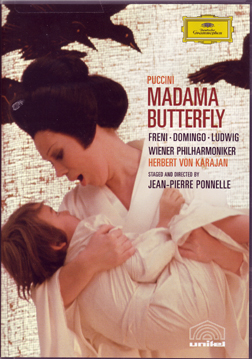
(845) 246-6944
· info@ArtTimesJournal.com
 |
The Thorny Road to Opera
as Film
By
FRANK BEHRENS
ART TIMES November 2005
When one films
an opera as opposed to merely videotaping a performance, there are two
paths to follow. One can simply film an existing production on the stage
with or without the presence of an audience or create the entire project
as a film using elaborate sets and even outdoor shots. The latter format
was tried with “Don Giovanni” in 1978 and “Carmen” in 1984--to name
but two. The 1951 “Tales of Hoffman” was shot entirely in a studio,
as was the 1967 “La Boheme.” They all had their good and bad points
and were seen by thousands of opera lovers.
When television
began to keep audiences home—and especially when tapes and then
DVDs made televised operas even more accessible—more and more
operas were filmed for the smaller screen. Three of these have recently
been released on DVDs by Deutsche Gramophone, and they demonstrate admirably
what is basically not right with all with this approach to making opera
easily available to the public.
The most important
negative about all of these attempts is the lip-synching of the cast
to an already recorded soundtrack. It is very difficult for even great
actors, let alone opera singers, to not only move their mouths in synch
to the soundtrack but to express the same emotions they did when making
the original recording. Somehow it simply never looks credible.
Another problem is the inconsistency of ambient sounds.
For example, in some scenes you hear footsteps, in others you do not.
And there is also the question of realistic settings clashing with the
fact that every one is singing to an invisible source of music. However,
all three of these productions are strongly cast, and one is willing
to suspend disbelief simply to enjoy the opera itself.
Puccini’s
“Tosca,” directed by Gianfranco de Bosio and conducted by Bruno Bartoletti,
has as its “gimmick” the actual settings in Rome in which the action
is supposed to take place: the church of Saint’Andrea della Valle and
the Castel Sant’Angelo. Placido Domingo (who else in the last 20 years?)
makes a believable Mario and Raina Kabavanska an attractive and sensitive
Tosca. A young looking Sherrill Milnes is a very handsome Scarpia, all
the more dangerous because attractive.
“Madama Butterfly,”
directed by Jean-Pierre Ponnelle and conducted by Herbert von Karajan,
is obviously using a prerecorded track and no effort is made to conceal
it. There is even that annoying cliché of having some lines “thought”
without any lip movement at all, not to mention freeze-frame and slow
motion. Again the cast makes you forget these (at least to me) distractions:
Placido Domingo (a kinder than usual Pinkerton), Mirella Freni (Butterfly),
Christa Ludwig (a fully characterized Suzuki), and Robert Kerns (a sympathetic
Sharpless).
Freni is absolutely
heartbreaking as she takes on her “husband’s” religion and national
dress, refusing steadfastly to believe she has been betrayed. The dream
she has about Uncle Sam, Teddy Roosevelt and others welcoming her to
the United States is a bit too silly and nearly identical to a dream
sequence in a nearly forgotten musical film “Delicious” with Janet Gaynor.
The only jarring note is the too-comic Goro of Michel Senechal, directed
to give a cartoonish characterization of the corrupt marriage broker.
The third,
“Le Nozze di Figaro” on two Deutsche Grammophon DVDs, directed again
by Ponnelle and conducted by Karl Bohm, might be the best acted performance
of this masterpiece on video; but the giving over of a good part of
the score to “the character is thinking this, not expressing it” becomes
more than distracting—it become annoying.
This is a
shame because the cast is filled with excellent actor-singers. Hermann
Prey gives us a maturer than usual Figaro and a dangerous one, while
Mirella Freni as his bride-to-be Susanna is perky and a good actress
to boot. Lieder singer Dietrich Fischer-Dieskau is an ice-cold Count,
hampered only by all the voice-overs during which he is required to
show facial expressions only. Indeed his great Act III aria is completely
voiced over, rendering it nearly meaningless.
Kiri Te Kanawa’s
Countess has nearly the same handicap, and her characterization is nowhere
near being a somewhat subdued Rosina from “The Barber of Seville.” But
then again, what sopranos in this role are? The comic villains Bartolo
(Paolo Montarsolo), Marcellina (Heather Begg) and Basilio (Jan van Kesteren)
are less cartoonish than in other productions. Most notable of all is
Maria Ewing’s as the page Cherubino, a nearly over the top adolescent
feeling his hormones.
“With all
your faults, I love you still,” is the
way I feel about these three offerings. Should any of you have
seen one or more of them—or indeed any other opera-on-film, I
would like to hear your opinions.